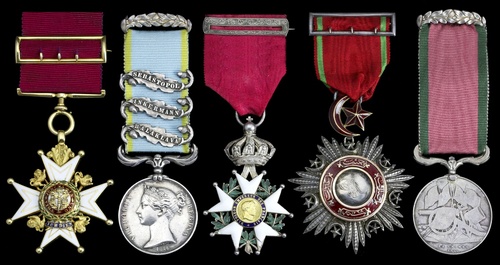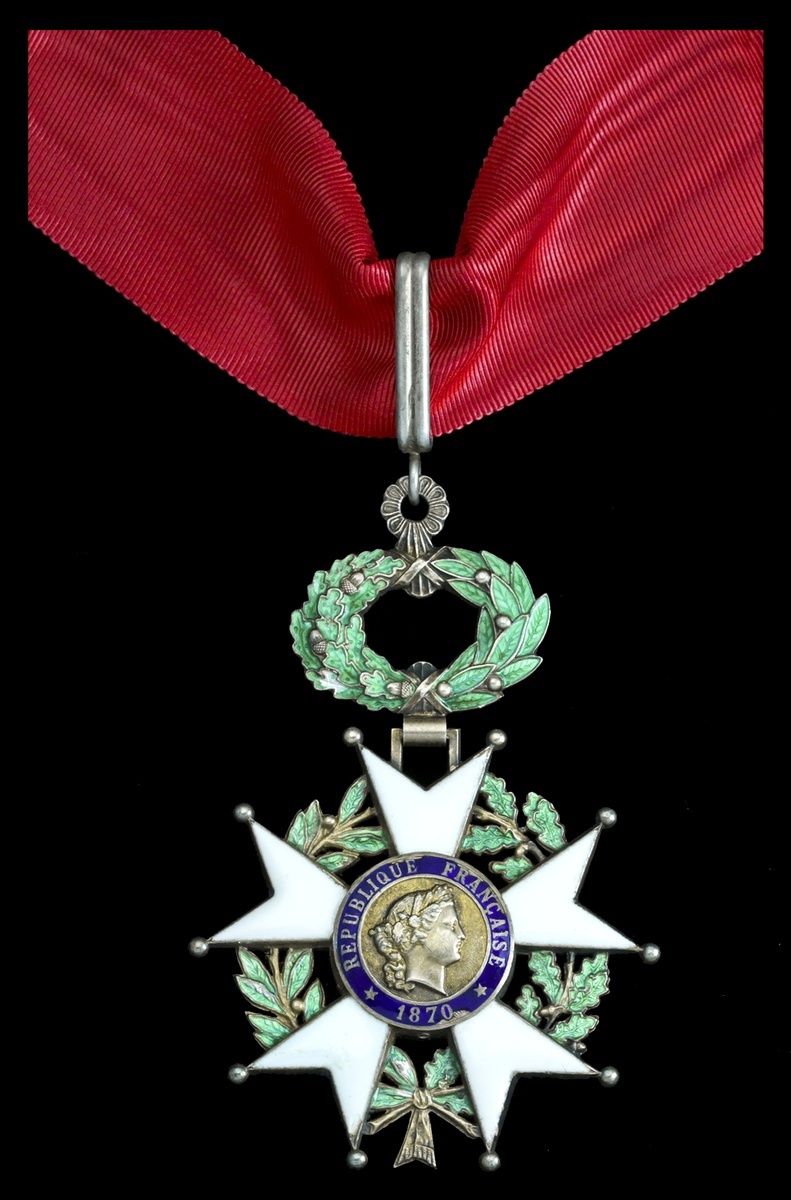Auction: 19001 - Orders, Decorations and Medals
Lot: 371
(x) 'O, mad for the charge and the battle were we,
When our own good redcoats sank from sight,
Like drops of blood in a dark-grey sea,
And we turn'd to each other, whispering, all dismay'd,
"Lost are the gallant three hundred of Scarlett's Brigade!"
"Lost one and all" were the words
Mutter'd in our dismay;
But they rode like victors and lords
Thro' the forest of lances and swords
In the heart of the Russian hordes.'
Alfred, Lord Tennyson, extract from The Charge of the Heavy Brigade (1854).
The impressive 'Heavy Brigade Charger's' group of six awarded to Lieutenant-General James Conolly, C.B., 5th Dragoon Guards, Brigade-Major to General Scarlett at the Battle of Balaklava on 25 October 1854.
Positioned right next to Scarlett as the 'gallant three-hundred' began their advance, Conolly was among the first to enter the fray. Concerned for the flanks, Scarlett sent him with orders to direct the first squadron of the Inniskilling Dragoons against the encroaching left wing of Ryzhov's cavalry: the 'Skins' accomplished this move in grand style, preventing the Heavy Brigade from being encircled.
Conolly charged with the Inniskillings, and was nearly unhorsed when a dead Russian fell across his saddle. He was warmly thanked in Scarlett's despatch to Lord Lucan two days later, and went on to become Military Attaché at Paris and Vienna.
The Most Honourable Order of the Bath, C.B. (Military) Companion's breast Badge, gold (18 carat) and enamel, hallmarks for London, fitted with narrow swivel-ring suspension and gold riband buckle; Crimea 1854-56, 3 clasps, Balaklava, Inkermann, Sebastopol (Major James Conolly. Cavy. Staff.), naming officially engraved by Hunt & Roskell in large serif capitals, fitted with a contemporary silver floral top riband buckle by B. Bailey, Coventry; France, Second Empire, Legion of Honour, 5th Class breast Badge, silver, gold centre and enamel; Third Republic, Legion of Honour, 4th Class neck Badge, gold and enamel, with length of neck riband; Turkey, Ottoman Empire, Order of the Medjidie, 5th Class breast Badge, silver, gold and enamel; Turkish Crimea, Sardinian issue, replacement 'Crimea' suspension, fitted with a contemporary silver floral top riband buckle by B. Bailey, Coventry, the second with light edge wear, some minor enamel loss throughout, the group very fine or better (6)
Provenance:
Christie's, November 1987, 'An important collection of officer's awards relating to the Crimean War.'
C.B. London Gazette 29 May 1875.
Legion of Honour Edinburgh Gazette 5 August 1856.
Order of the Medjidie London Gazette 2 March 1858.
James Conolly was born in 1818. He entered the 5th (Princess Charlotte of Wales's) Dragoon Guards as a Cornet on 17 June 1836. Promoted to Lieutenant on 28 November 1837 and Captain on 14 March 1845, he served in the Crimean War as Brigade-Major of the Heavy Brigade, commanded by the Hon. James Yorke Scarlett.
Following the British capture of Balaklava during the southward 'Flank March', Lord Raglan positioned the Cavalry Division on the eastern slope of the Sapoune Ridge, ready to attack the flank of any Russian move on the port. At dawn on 25 October, the Anniversary of Agincourt, a Russian force of 22,000 infantry, 3,400 cavalry and 78 guns commanded by General Liprandi poured onto the plain to the north of Balaklava, overwhelming the inadequate British redoubts along the Woronzoff Road. Four squadrons of Russian cavalry detached themselves from the main body and dashed towards Balaklava, but foundered against the resolute 93rd (Sutherland) Highlanders in an incident known as 'The Thin Red Line'. The remaining 3,000 horsemen under General Ryzhov, comprising Hussars and Cossacks, advanced westwards down the South Valley and towards the Heavy Brigade.
Ryzhov caught the Heavy Brigade unprepared and at a disadvantage. From high up on the Sapoune Ridge, Lord Raglan, the British Commander-in-Chief, had ordered the Heavy Brigade to send eight squadrons to support the 93rd Highlanders. Strung out and dispersed, the British cavalry were stunned by the appearance of Ryzhov's main body, just 800 yards distant. Scarlett, at his Brigade's head, had with him only two squadrons of the Scots Greys and one of the Inniskillings - about 300 men.
Tennyson's 'gallant three-hundred' coolly formed up with parade-ground evolutions, its officers unhurriedly checking their men's dressing. Taken aback by their enemy's imperturbability, the Russian masses suddenly halted just 350 yards from the Heavy Brigade, despite occupying the higher ground (Pemberton 1962, 85). Scarlett placed himself far in advance of his men. He had with him his A.D.C., Lieutenant Elliot, his Brigade-Major, Captain Conolly, and his trumpeter, an Irish giant named Shegog. Seeing that his small force was being outflanked, Scarlett despatched Captain Conolly with orders to direct the uncommitted squadron of the Inniskillings against the encroaching Russian left. The following is extracted from Kinglake, Vol. 4:
'Captain Conolly, Scarlett's Brigade Major, had ridden to the second squadron of the Inniskillings who charged the left flank of the Russians across good ground, free from the impediments of the cavalry camp. They smashed into the back of the inward-wheeling wing and so tightly did they become locked, Conolly found his arms held by the dead body of a Russian who had fallen across his saddle.'
Taking the Russians obliquely on the bridle hand, this squadron's attack was perfectly timed. With the arrival of the 4th and 5th Dragoon Guards and the 1st (Royal) Dragoons, the now-complete Heavy Brigade evicted the Russians from the South Valley as 'C' Troop, Royal Horse Artillery prevented them regrouping. The whole engagement lasted no more than ten minutes.
Conolly was warmly thanked in Scarlett's report to Lord Lucan dated 27 October, and on 12 December he was promoted to Major (Dutton 2008, 24). He received the 5th Class of the Legion of Honour and of the Medjidie, and continued to serve with Scarlett as Assistant Quartermaster-General at Aldershot. He was military attaché at Vienna and Paris successively, receiving the 4th Class of the Legion of Honour during the latter appointment. Made a Companion of the Bath in 1875, he attained the rank of Lieutenant-General in 1880. He died at Wiesbaden, Germany on 22 June 1885; sold with a file of copied research.
Reference works:
Pemberton, W. B., Battles of the Crimean War (London, 1962).
Dutton, R., Forgotten Heroes: The Charge of the Heavy Brigade (Oxton, 2008).
Kinglake, A. W., The Invasion of the Crimea, Vol. IV (Edinburgh, 1901).
Subject to 5% tax on Hammer Price in addition to 20% VAT on Buyer’s Premium. For more information please view Terms and Conditions for Buyers.
Sold for
£4,500







